Babubhai Mistry
| Babubhai Mistry | |
|---|---|
 | |
| Born |
Saptember 05,1918 Surat, Gujarat |
| Died |
20 December 2010 Mumbai |
| Other names | Babubhai Mistri |
| Occupation | film director, special effects director |
| Years active | 1933-1991 |
| Known for | special effects, mythological films |
Babubhai Mistry (Saptember 05,1918 – 20 December 2010) was an Indian film director and special effects pioneer who is best known for his films based on Hindu mythology, such as Sampoorna Ramayana (1961), Mahabharat (1965), and Parasmani (1963).
In 1999, Mistry received the Lifetime Achievement Award at the Zee Cine Awards.[1] In 2009, he was honored "for his contribution to Bollywood as the master of special effects" at an event, "Immortal Memories," held to honor the "living legends" of the Hindi film industry.[2]
Early life and education
Babubhai was born in saiyedpura area of Surat, Gujarat and studied until class four.[3]
Career
Babubhai was a regular art director for various movies produced Wadia Movietone owned by JBH and Homi Wadia brothers along with Fearless Nadia. Here he discovered his penchant for handling camera and trick photography. He trained with Vijay Bhatt at Basant Pictures as a special effects director from 1933 to 1937. Khwab Ki Duniya (1937) came to him after Vijay Bhatt asked him to go and watch American film The Invisible Man (1933) and later asked whether he would be able to replicate them for a film, thus started his career in special effects.[4] In fact his special effects in the film earned him the nickname Kala Dhaga (black thread) for the black threads he used in the film for performing various tricks. Thus Khwab Ki Duniya was the first film in which he was credited as "trick photographer". In the coming years, he also received acclaim for his effects in Basant Pictures' Hatimtai (1956) directed by Homi Wadia and Ellis Duncan's Meera (1954).[4][5]
Mistry soon became a director and a cameraman. He started his directing career by co-directing his first two films, Muqabala (1942) and Mauj (1943) with Nanabhai Bhatt, both starred Fearless Nadia. Over the next four decades, he gathered stories from diverse religious, epical and language texts, such Puranas,[6] and went on to direct over 63 fantasy, mythological and religious films, including Sampoorna Ramayana (1961), "a milestone in the history of Hindu mythology",[7] Parasmani (1963) and Mahabharat (1965). Later, he also remained a consultant for Ramanand Sagar's television epic series, Ramayan (1987-1988). In 2005, at the annual MAMI festival he was awarded the Kodak Trophy for Technical Excellence for his contribution to Indian cinema.[8]
Filmography
- Director
- Muqabala (1942)
- Mauj (1943)
- Sampoorna Ramayana (1961)
- King Kong (1962)
- Parasmani (1963)
- Mahabharat (1965)
- Bhagwan Parshuram (1970)
- Daku Man Singh (1971)
- Saat Sawal (1971)
- Hanuman Vijay (1974)
- Alakh Niranjan (1975)
- Amar Suhagin (1978)
- Har Har Gange (1979)
- Sant Ravidas Ki Amar Kahani (1983)
- Kalyug Aur Ramayan (1987)
- Hatim Tai (1990)
- Special effects
- Khwab Ki Duniya (1937)
- Aladdin Aur Jadui Chirag (1952)
- Jungle Ka Jawahar 1953
<sup class="noprint Inline-Template "noprint Inline-Template"" style="white-space:nowrap;">[check quotation syntax]* Hatim Tai (1956)
- Meera (1954)
- Zimbo (1958)
- Angulimaal (1960)
- Guru (1980)
- Cinematographer
- Kaash (1993)
Notes
- ↑ Zee awards Indian Express, 1 March 1999.
- ↑ "When yesterday blessed today". IndiaGlitz.
- ↑ "Babubhai Mistry".
- 1 2 Gulzar., p. 490
- ↑ Dawyer, p. 171
- ↑ Watkins, p. 85
- ↑ Watkins, p. 89
- ↑ Dawyer, p. 44
References
- Gulzar; Govind Nihalani; Saibal Chatterjee (2003). Encyclopaedia of Hindi Cinema: An Enchanting Close-Up of India's Hindi Cinema. Popular Prakashan. ISBN 8179910660.
- Rachel Dwyer (2006). Filming the Gods: Religion And Indian Cinema. Psychology Press. ISBN 0415314240.
- Gregory J Watkins (2008). Teaching Religion and Film. Oxford University Press. ISBN 0195335988.
